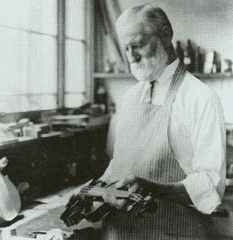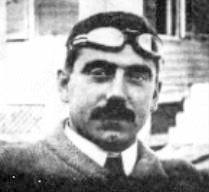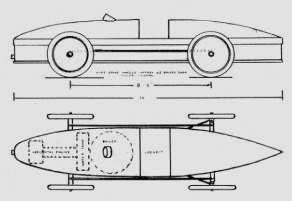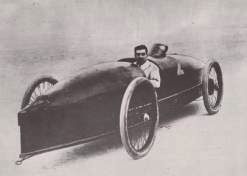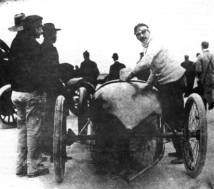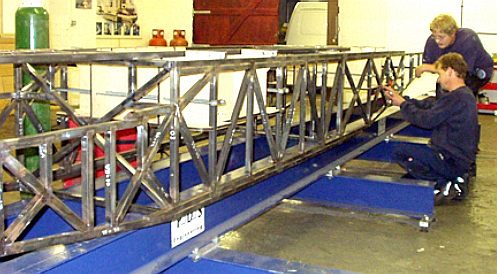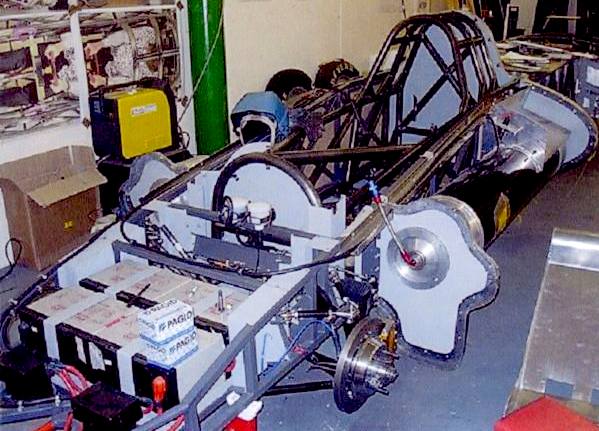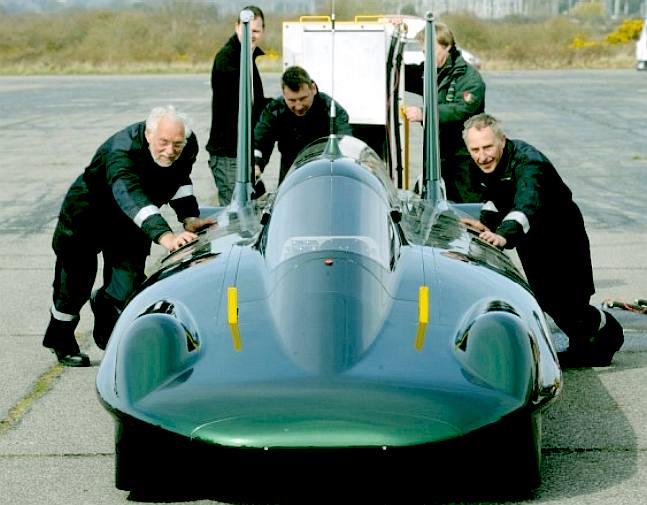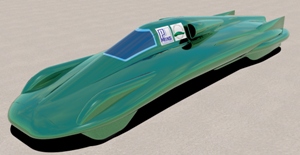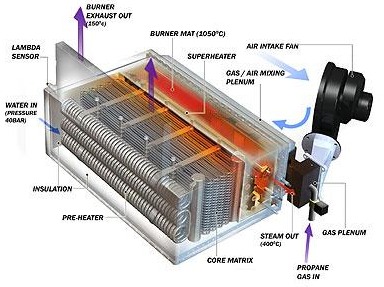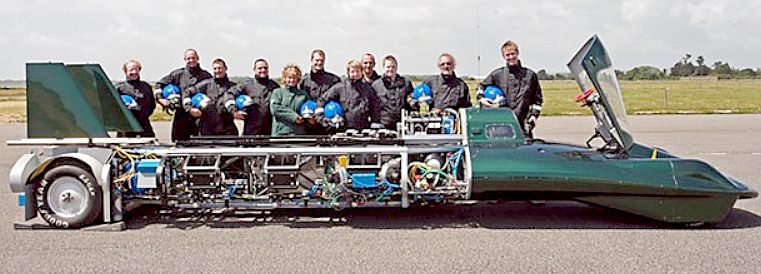|
BRITISH STEAM CAR CHALLENGE
|
|
|
STANLEY STEAMER 1906 and BRITISH STEAM CAR CHALLENGE 2004
The British Steam Car Challenge was conceived with the twofold aim of breaking the land speed record for steam powered vehicles as well as creating excitement in the arena of alternate fuels. It is hoped that the project will create interest among the next generation of engineers and designers to work toward cleaner and safer forms of transportation, both public and private.
The longest standing steam Land Speed Record was set in 1906. With driver Fred Marriot at the wheel, the Stanley Steamer managed 127.659 mph.
F. O. Stanley and Fred Marriot
In 1906 the sands of Ormond Beach, now called Daytona Beach, hosted internationally; recognized land speed record attempts. The Dewar International Trophy was to straightaway land speed competition what the Americas Cup was to yachting. The only vehicles vying for the Dewar Trophy that year were the Stanley’s steamer and four petrol powered cars, three being Fiats and one Napier. Fred Marriott won cleanly in the Stanley Steamer with a measured mile time of 28 1/5 second which corresponds to a speed of 127.659MPH.
The record set in 1906 is of significance as it is the longest standing FIA recognized LSR. It was set in the days when gasoline powered internal combustion engines were competing neck-and-neck with steam powered external combustion engines for commercial market share. In the midst of this commercial battle were twin brothers F.E. and F.O. Stanley, known for their Stanley Steamer. Their innovative vehicles were in very high demand early in the 1900s. Their shop constructed several thousand cars in the early part of the nineteenth century but they were overshadowed by the petrol powered internal combustion engines gaining prevalence in the market.
Stanley Steamer - Drawings and under power
The car was constructed by the Stanley brothers and was a technological marvel for its day. The Stanley brothers created a car that had extremely low drag, incorporating as much inside the cigar shaped body shell as possible including the suspension springs. The engine was a twin piston double acting type with a displacement of 184 cubic inches or 3.1 litres. This corresponds roughly to an internal combustion 4 stroke V8 with a displacement of 735 cubic inches or 12.25 litres. The working pressure claimed to be either 275 or 1000 psi depending on the report with a temperature of 700 degrees F. With the power required to drive the vehicle at the recorded speeds the 1000 psi is most likely the correct figure. The car was 16 feet long and 3 ft wide at its widest part with a total frontal area of 9 sq. ft including wheels. The total vehicle weight was 1675 lbs.
PDS engineers working on the steam car frame. Note that two heavy RSJs are placed on four shorter transverse beams that have adjustable feet. This enables to team to compensate for an uneven concrete floor.
1999 - 2009
In 1999, the British Steam Car Challenge was launched with the twofold aim of breaking the land speed record for steam powered vehicles as well as creating some excitement in the arena of alternate fuels. It is hoped that the project will help the trend toward more fuel efficient and cleaner burning vehicles for the future of transportation. The project was officially kicked off in June of 1999 with a luncheon hosting members of the team, sponsors and distinguished guests including Lord Montagu of Beaulieu as the patron of the project. The car, named Inspiration after the effect we hope it will have, is to be on loan to the National Motor Museum Trust at Beaulieu after the 200 MPH barrier has been broken.
The first mention of a steam powered vehicle will usually conjure images of ancient tiller steered motor cars and pre-war rail engines. It was during the early nineteen hundreds that the petrol engine gained dominance in the personal transportation marketplace. While not exactly new in concept, steam powered vehicles have potential that today’s internal combustion engines lack. While the compact size and robust power density figures make the internal combustion engine attractive, its drawback also stems from its popularity.
Annette Getty - PDS have been recently working closely with the designer from the British Steam Car Challenge Team to shape and build special steel tubing for the chassis of this exciting project. We began the process by cutting the square section T59 tubes into lengths and then machining them extremely accurately to create the piece parts required for assembling by welding together on the special Jig that we built in our factory in Nelson. The car is designed to exceed 300 mph and could be the fastest ever vehicle to be powered by steam.
The current reliance of the internal combustion engine on highly refined hydrocarbon based fuels makes the external combustion engine an attractive concept for many applications. External combustion engines such as the steam engine are not fuel specific, meaning that any fuel can be used.
Similarly, the technology used in the project is far from antiquated. In fact, some leading edge technologies have been employed to make the record attempt possible. The development phase of the project includes over 18 months of proof-of-concept and research work on the steam generation and power delivery systems. Students quickly developed a vehicle that would, in theory, set a new record. They devised the shape and general concept of the project including the amount of power required to push that shape to the 200 MPH mark.
British LSR Steam Car 2004 concept and the boiler schematic
The team say that the most enduring part of the project is the ongoing education of students and the public after the Land Speed Record has been set. What we have accomplished with this vehicle is an integrated approach to a land speed record. An innovative boiler design, high performance turbine, aerodynamically slippery shape and clean burning fuel all combine to make this vehicle an extremely technologically and ecologically advanced project. But the overall aim of the project is to promote education and awareness of clean burning fuels and ecologically sound technologies to young engineers all over Britain.
It is the hope of the team and many of the project supporters to bring another land speed record to Britain. The car is being designed and constructed in the UK, and the first of two record attempts will be made in the UK. Automotive racing has always pushed the envelope of technology and led the forefront of automotive change. Man’s desire to go faster has led to advances in existing capabilities.
THE TEAM:
Driver - Charles BurnettLady Driver - Annette Getty Chief Designer - Glynne BowsherConsulting Engineer - Peter CandySystems Design - Jeremy BlissInternet - Jeremy DaveyLPG System Designer - John KingProject Instigator - Dr. Neil RichardsonEngineering Logistics Coordinator - Frank SwanstonTeam Coordinator and Administrator - Lynne Angel Senior Test and Car Build Technician - Shaun Arnold
STEAM CAR LINKS:
http://www.pdsengineering.co.uk/blog/the-british-steam-car-world-record-speed-challenge http://www.pdsengineering.co.uk/blog/the-british-steam-car-world-record-speed-challenge
|
|
|
This
website is Copyright © 2014 Bluebird Marine Systems
Limited.
The names Bluebird™,
Blueplanet BE3™, Ecostar
DC50™
and the blue bird in flight
|
